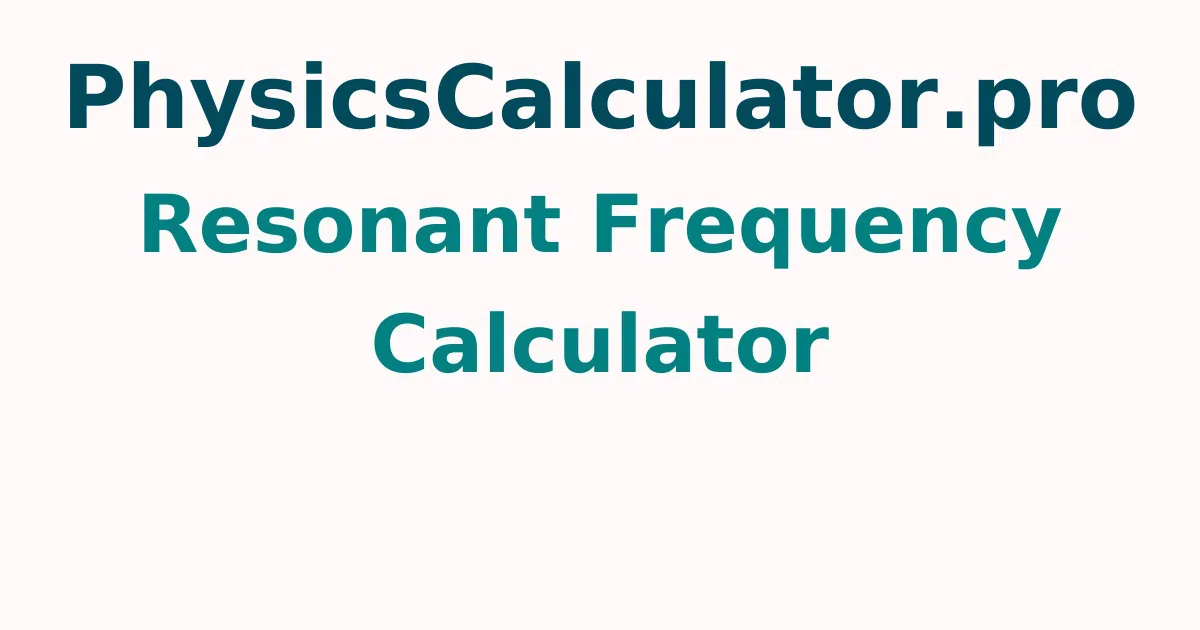Resonant Frequency Calculator
Get the resonant frequency for the LC Circuit with the help of our simple to use Resonant Frequency Calculator tool. Simply enter the capacitance and inductance values in the calculator's designated input fields and press the calculate button to get the result.
Resonant Frequency Definition
The frequency observed in the LC circuit is the resonant frequency. It is the system's inherent frequency. The resonant frequency is the frequency at which the transfer function's greatest value is reached. Electrical, optical, mechanical, orbital, and molecular resonances are among the several forms of resonances.
The resonant frequency is calculated using the following formula: f = 1/[2π x √(L x C)]
- Where, f = Resonant Frequency
- L = Inductance
- C = Capacitance
What is an LC Circuit (Tank Circuit)?
An LC circuit (also known as a resonant circuit, tank circuit, or tuned circuit) is a zero-resistance idealised RLC circuit. In a parallel or series design, it merely has an inductor and a capacitor
Signal generators and bandpass filters are prominent uses for tank circuits, which pick a signal at a specific frequency from a more complex signal. LC circuits can be found in amplifiers, oscillators, tuners, radio transmitters, and receivers, among other places in electronics. Filtering a signal with LC and RC circuits is possible by blocking particular frequencies.
How to find Resonant Frequency?
Follow the procedures outlined below to quickly determine the LC Circuit's resonant frequency.
- Step 1: Get the LC Circuit's inductance and capacitance.
- Step 2: Multiply inductance and capacitance together.
- Step 3: Apply the square root to the product.
- Step 4: Multiply the result by 2π
- Step 5: To check the resonant frequency, get the reciprocal of the resultant product.
How to Use the Resonant Frequency Calculator?
The following is the procedure how to use the resonant frequency calculator
- Step 1: In the input field, enter the capacitance, inductance, and x for the unknown.
- Step 2: To calculate the resonance frequency, click the "Calculate x" button.
- Step 3: Finally, in the output field, the L-C resonance frequency will be displayed.
For more concepts check out physicscalculatorpro.com to get quick answers by using this free tool.
Resonant Frequency Examples
Question 1: Calculate the resonance frequency of an LC circuit with an 8 mH inductor and a 5µF capacitor?
Solution:
Given:
Inductance L = 8 mH = 8 x 10^-3
Capacitance C = 5 µF = 5 x 10^-6
Resonant frequency is f = 1/[2π x √(L x C)]
f = 1/[2π x √( 8 x 10^-3 x 5 x 10^-6)]
f = 0.00795 MHz
Therefore, the resonant frequency is 0.00795 MHz.
FAQs on Resonant Frequency
1. What is the formula for calculating resonant frequency?
To get the resonance frequency of a single continuous-wave, use the formula v = λf, where, v = velocity, λ = wavelength distance
2. Is it true that the resonance frequency is always 1 sqrt LC?
Only if you have an ideal LC-circuit with zero damping does the resonance frequency (in radians per second) equal √(LC).
3. How do you calculate the second resonant length?
The open ends of an open-air column will be antinodes. As a result, the wavelength is the second resonant length. Closed ends of a closed air column will be nodes.
4. What is the capacitor's self-resonant frequency?
The self-resonance frequency is the frequency at which the insertion loss starts to reduce. It's the frequency at which the capacitor's impedance drops to zero.
5. Why is amplitude maximum at resonance?
A periodic force drives a harmonic oscillator at its inherent frequency, which results in resonance. The device is reported to resonate. The amplitude of near-resonance induced oscillations increases as the damping of a system decreases.
6. What is water's resonant frequency?
The water molecule's lowest resonance frequency is 22.235 GHz. This frequency is nearly ten times higher than the microwave oven's working frequency (2.45 GHz).
